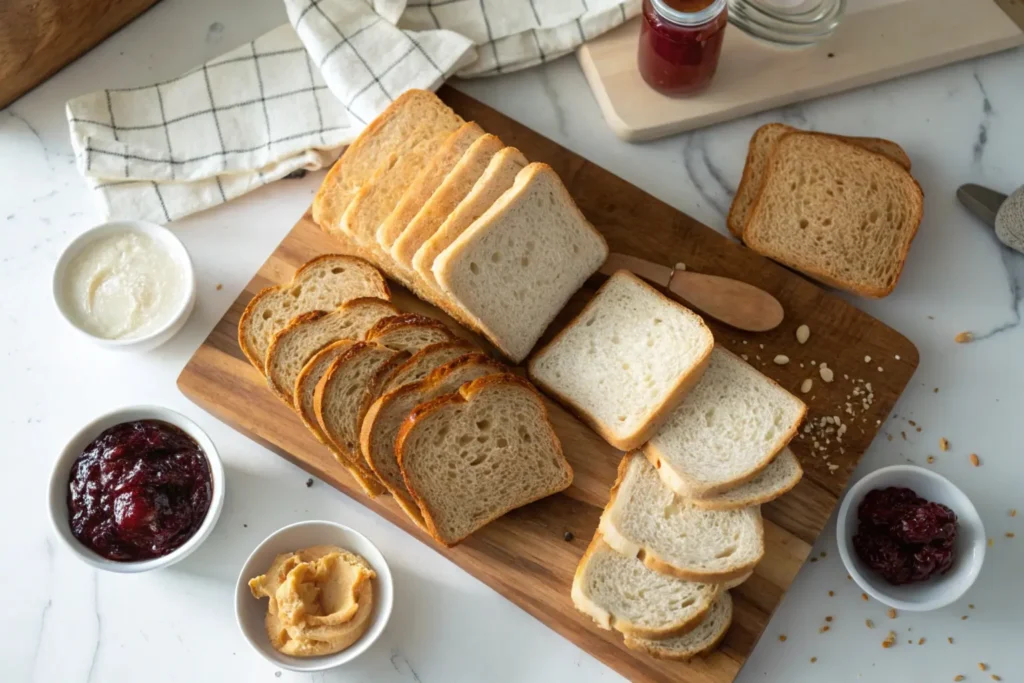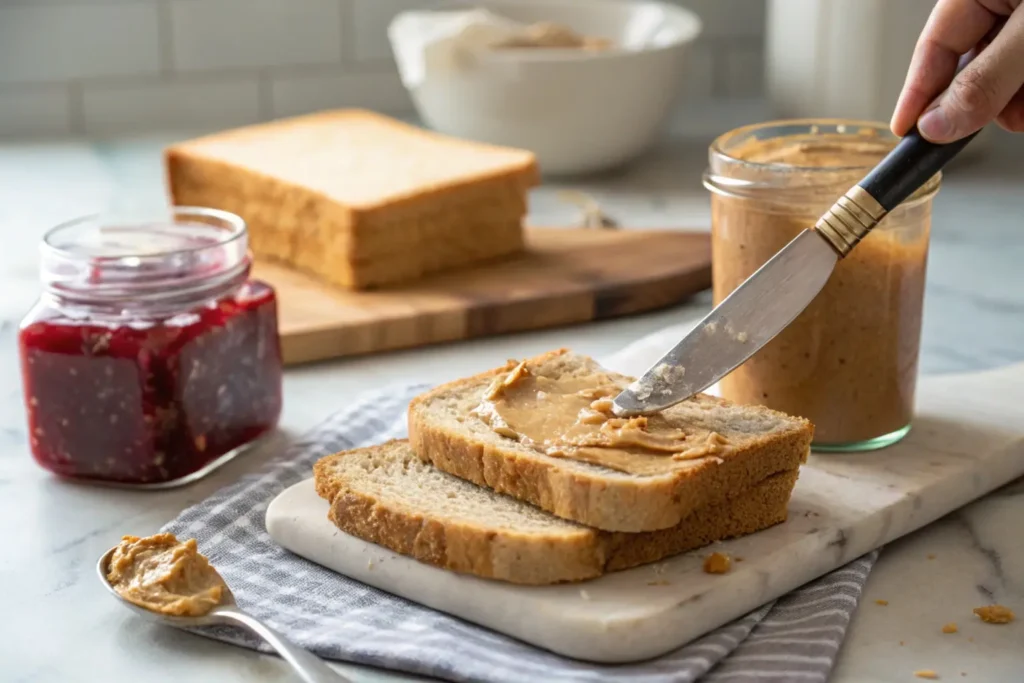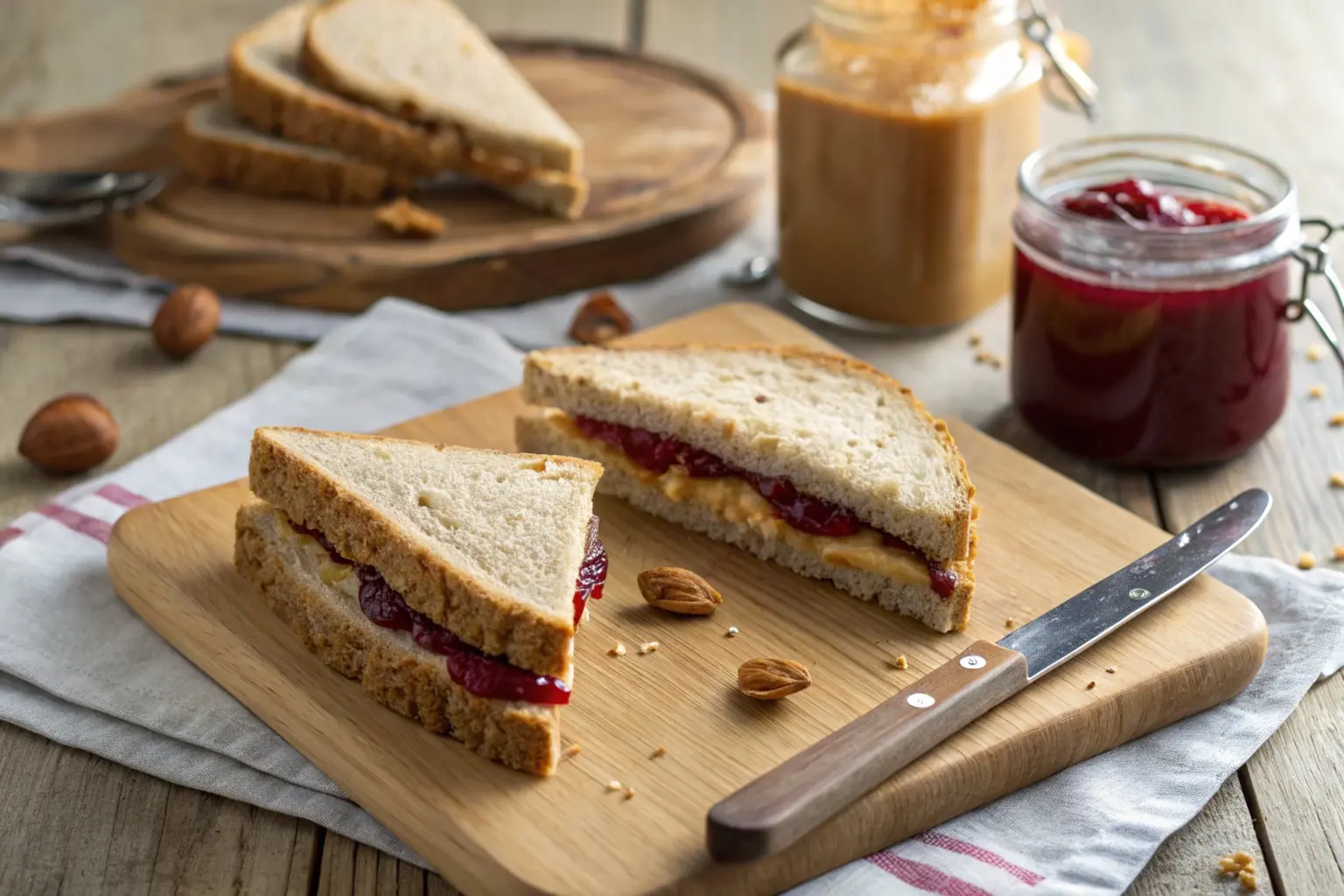Peanut butter and jelly sandwiches are more than just a classic snack—they’re a staple of childhood, a comforting go-to meal, and even a nostalgic treat for adults. But have you ever wondered what kind of bread is best for peanut butter and jelly? While any bread can work in a pinch, choosing the right bread can elevate your PB&J experience to new heights.
In this article, we’ll explore the best bread options for this iconic sandwich. We’ll discuss traditional choices like white and whole wheat bread, dive into modern favorites like multigrain and sourdough, and even introduce unique bread ideas to make your PB&J stand out. Plus, we’ll share tips for selecting the perfect loaf and answer common questions to help you craft the ultimate peanut butter and jelly sandwich. Let’s get started!
Table of Contents
Exploring Bread Choices for Peanut Butter and Jelly
Traditional Options: White and Whole Wheat Bread
When it comes to what kind of bread is best for peanut butter and jelly, white and whole wheat bread often top the list. White bread is a nostalgic classic, known for its soft texture and neutral flavor that allows the peanut butter and jelly to shine. Its mildness makes it especially appealing to kids or those who prefer a simple, fuss-free sandwich.
On the other hand, whole wheat bread brings a nuttier flavor and a firmer texture to the table. Packed with fiber and nutrients, it’s a healthier alternative to white bread. The slightly dense structure of whole wheat bread helps it hold up better to thick layers of peanut butter and jelly, making every bite as satisfying as the first.
Modern Favorites: Multigrain and Sourdough
For those seeking a more gourmet experience, multigrain and sourdough bread are excellent choices. Multigrain bread combines the richness of various grains and seeds, adding depth of flavor and a delightful crunch. It’s a perfect pairing for natural peanut butter, as the nutty elements complement each other beautifully.
Sourdough bread, with its tangy flavor and chewy texture, adds an unexpected twist to the classic PB&J. The subtle sourness of the bread contrasts with the sweetness of the jelly, creating a balanced and complex flavor profile. Plus, its sturdy structure prevents the sandwich from becoming soggy, even with generous amounts of jelly.
Benefits of Using Different Bread Types
Health Benefits of Whole Wheat and Multigrain Bread
When deciding what kind of bread is best for peanut butter and jelly, health-conscious eaters often lean toward whole wheat or multigrain bread. Whole wheat bread is rich in fiber, vitamins, and minerals, which help improve digestion and provide sustained energy. Its hearty texture pairs beautifully with creamy peanut butter, offering a satisfying bite.
Multigrain bread takes it a step further by incorporating seeds and grains like flax, oats, or sunflower seeds. These ingredients boost the bread’s nutritional profile, adding healthy fats, protein, and even more fiber. A PB&J made with multigrain bread isn’t just tasty—it’s a wholesome snack or meal that keeps you full longer.
Taste and Texture Advantages of Sourdough and Rye Bread
While health benefits are important, taste and texture are equally critical when choosing what kind of bread is best for peanut butter and jelly. Sourdough bread is an unexpected favorite for PB&J lovers. Its tangy flavor adds a surprising depth that balances the sweetness of jelly and enhances the nuttiness of peanut butter.
Rye bread, though less common for PB&J, offers a robust and earthy flavor that pairs well with fruit-forward jellies like raspberry or blackberry. Its firm structure prevents sogginess, ensuring a consistently enjoyable sandwich. For those seeking bold flavors and chewy textures, sourdough and rye are worth a try.
Tips for Choosing the Right Bread for PB&J
Pairing Bread with Peanut Butter and Jelly Flavors

The key to crafting the perfect PB&J is choosing bread that complements your chosen peanut butter and jelly flavors. If you’re using a sweet jelly like grape or strawberry, white bread offers a neutral base that lets the fillings shine. On the other hand, whole wheat or multigrain bread pairs beautifully with natural peanut butter and less sweet jams, like apricot or orange marmalade.
For adventurous eaters, sourdough bread can handle bolder combinations, such as crunchy peanut butter and tart raspberry jelly. The tanginess of the sourdough elevates the overall flavor profile, creating a sandwich that feels both indulgent and sophisticated.
How Freshness Impacts the Sandwich Experience
Freshness is a crucial factor when determining what kind of bread is best for peanut butter and jelly. Stale or dry bread can ruin the experience, making your sandwich less enjoyable. Always use fresh bread for a soft, flavorful base that enhances the creamy peanut butter and fruity jelly.
If you want to keep your bread fresher longer, store it in an airtight container or the freezer. Frozen slices can be thawed and toasted, providing a crisp base that holds up well to spreads. For softer sandwiches, simply let the bread reach room temperature before assembling your PB&J.
Unique Bread Ideas to Elevate Your PB&J
Using English Muffins and Bagels for PB&J
When thinking about what kind of bread is best for peanut butter and jelly, don’t limit yourself to traditional slices. English muffins, with their nooks and crannies, are a fantastic choice. The textured surface holds onto spreads beautifully, ensuring every bite is bursting with peanut butter and jelly goodness. Toast them lightly for a crunchy, flavorful base that adds a new dimension to this classic sandwich.
Bagels are another creative option. Their dense texture makes them a sturdy foundation for thick layers of peanut butter and jelly. Opt for plain, whole wheat, or even cinnamon raisin bagels to match your preferred flavors. The chewiness of the bagel paired with creamy peanut butter and sweet jelly creates a satisfying and indulgent treat.
Sweet Bread Options Like Brioche and Hawaiian Rolls
For a sweeter twist on the traditional PB&J, brioche and Hawaiian rolls are perfect alternatives. Brioche’s buttery, soft texture complements the rich peanut butter and sweet jelly, creating a dessert-like sandwich that feels luxurious. Similarly, Hawaiian rolls, with their slightly sweet flavor, add a tropical flair to this beloved combo. Use mini rolls to make bite-sized PB&J sliders for a fun and shareable snack.
If you’re hosting a gathering, these sweeter bread options are sure to impress. Their unique flavors and textures elevate the humble PB&J into something truly special.
Low-Carb or Gluten-Free Alternatives
For those with dietary restrictions, there are plenty of low-carb and gluten-free bread options available. Almond flour or coconut flour bread is a great choice for keto diets, while gluten-free sandwich bread ensures everyone can enjoy this classic without worry. These alternatives are widely available in stores or easy to make at home.
How to Make the Perfect Peanut Butter and Jelly Sandwich
Spreading Techniques to Avoid Sogginess

Crafting the perfect PB&J is truly an art, and it all begins with how you spread the ingredients. To start, creating a barrier by spreading peanut butter on both slices of bread is crucial. By doing this, the layer of peanut butter prevents the jelly from soaking into the bread, ensuring your sandwich stays intact. Additionally, using a butter knife or spatula helps achieve even coverage, leaving no empty spots behind.
On the other hand, if you prefer a thinner layer of peanut butter, you can spread a small amount on one side and add jelly to the other. In this case, using the back of a spoon to evenly distribute the jelly is a great way to ensure a mess-free experience. Ultimately, these simple techniques can make all the difference in creating a PB&J that’s both delicious and structurally sound.
Layering Tips for Balanced Flavors
Getting the balance of flavors just right is key to a delicious PB&J. Start with a generous layer of peanut butter to provide creaminess and protein. Follow it up with your chosen jelly, ensuring it’s not too thick to overpower the sandwich. For an extra burst of flavor, try combining two jellies, like strawberry and grape, for a fun twist.
For those who enjoy crunchy textures, use crunchy peanut butter or sprinkle crushed nuts over the jelly layer. This simple addition creates a delightful contrast in every bite.
Creative Add-Ons Like Bananas, Honey, or Nuts
To take your PB&J to the next level, consider adding creative ingredients. Sliced bananas add natural sweetness and a creamy texture, while a drizzle of honey enhances the flavor profile. For extra crunch, sprinkle chia seeds, granola, or crushed nuts between the layers. These add-ons not only boost the flavor but also make the sandwich more nutritious.
FAQs About Choosing the Best Bread for PB&J
What’s the Best Bread for Kids’ PB&J?
When it comes to making peanut butter and jelly sandwiches for kids, simplicity is key. So, what kind of bread is best for peanut butter and jelly for younger palates? White bread is often the top choice because of its soft texture and mild flavor. It’s easy for little ones to chew and pairs perfectly with classic peanut butter and jelly flavors like grape or strawberry.
For a slightly healthier option, whole wheat bread works well, offering more nutrients without sacrificing the soft texture that kids love. Look for varieties labeled as “soft whole wheat” to ensure your PB&J is both kid-friendly and nutritious.
Can I Use Gluten-Free Bread for PB&J?
Yes! If you’re gluten-sensitive or prefer gluten-free options, there are plenty of bread varieties that can make a fantastic PB&J. Brands specializing in gluten-free bread offer soft, sandwich-friendly loaves that mimic the texture of traditional bread. Options made with rice flour, almond flour, or sorghum flour are great substitutes.
To make a gluten-free PB&J even more enjoyable, consider toasting the bread slightly. This adds a bit of crispiness, which complements the creamy peanut butter and fruity jelly.
Is Toasted Bread Better for PB&J?
Toasting your bread is a game-changer for some PB&J fans. While untoasted bread provides a classic, soft bite, toasted bread adds a crisp texture that contrasts beautifully with creamy peanut butter and gooey jelly. For what kind of bread is best for peanut butter and jelly when toasted, sourdough and multigrain bread shine due to their sturdier structures.
However, keep in mind that toasting may make the sandwich slightly messier, as the jelly can slide off the crisp surface. To avoid this, spread your peanut butter first and press the slices gently together before serving.

